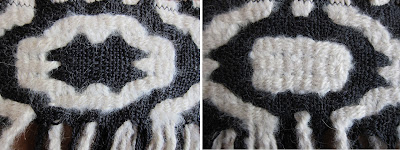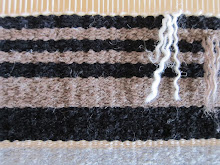Penland School of Crafts
Session 4
July 5 - July 17, 2015
Beginning Weaving
Instructor: Bhakti Ziek
Cast of Characters:
 |
| Book woven by Haley Toelle in spider weave (deflected warps and wefts) |
Almost immediately each student found their own path. This was a group that grasped the principles of weave so quickly that I had to abandon any thought of a plan, and just let each of them lead the way. You can see from the images above that they explored a huge variety of woven possibilities--twills, overshot, monk's belt, huck lace, block weaves, double corduroy, double weave, tapestry, clasped wefts, woven shibori, deflected warps and wefts, pulled thread plain weave, and shaped plain weave. There was more, and of course there were color and material studies along with the structural research. Clean selvedges were not stressed but they all wove long lengths with straight edges. This class had all winners. And watching them, I was the biggest winner of them all. I love weaving--everyone who knows me knows how enthusiastic I can get about the process of weaving--but these new weavers made me love weaving even more.
Visitors & Excersions:
 |
| Amanda Thatch, coordinator of fibers, and one of her ikat weavings below |
 |
| Catharine Ellis showing piles of her woven shibori fabric which she dyed with natural dyes |
 |
| Alice Schlein visited the class and wowed everyone with her handwoven jacquards and books |
I didn't get pictures of the afternoon visit we had by Susan Morgan Leveille but it was quite a treat. Susan is the great niece of Miss Lucy Morgan, and everyone who goes to Penland knows about Miss Lucy. Susan had some clothing with her that Miss Lucy had woven and worn. Now that was a true piece of Penland history. One student, Donna Anthony, was the one student who contacted me ahead of time saying she had taken two classes before but felt she could benefit from the class--and I encouraged her to sign up and that I would work with her at her level, as long as she understood that rank beginners needed more help the first days than others. Donna came into the studio one afternoon saying she had just bumped into her first teacher--who turned out to be Susan!
Our class spent one evening before dinner with Edwina Bringle hearing stories about the early 60s at Penland and the transition from Miss Lucy's times to today. I loved sitting there looking at my students and thinking that we were the current moment in this long history. Is anything more perfect than sitting on the deep porch of Craft House drinking wine and listening to old Penland stories?
We also were invited to a short visit to the archives by Penland's archivist, Carey Hedlund. Among the things that Carey showed us were some samples woven by Miss Lucy Morgan as well as an old shuttle, that showed the patina of use and love, that might have been used by Miss Lucy.
 |
| Details of looms at Valdese Weavers |
 |
| Picnic after mill visit--happy and exhausted |
 |
| Monica Brown, Daniel Garver and Jackie Sullivan teamed together to design, weave and sew this poncho, that they will continue to share. Penland really makes connections. |
 |
| Cleaning up the studio on July 17th before putting up finished work at Northlight |
It has taken me weeks to cull through the hundreds of images I took at Penland and try to eliminate them down for this post. Even so, it is long. How do you distill a time warp into a blog post? It was two weeks where time was so compressed that at the end of the two weeks you felt like you were saying goodby to people you had known your whole life. It felt like two weeks that really changed lives. I know it brought a very needed reinvestment of energy into my life. I often talk about being exiled in Vermont--but I left feeling appreciated and relevant. I left with renewed respect for weaving and its importance in people's lives. I left with hope for the future. I left very much feeling present. To paraphrase something I heard someone say the other day, it did wonders for my zen.
Final Exhibition:
 |
| Ceramics by Robin Ziek made in Kip O'Krongly's class |
 |
| Shots of the weavers putting up their work at the final Northlight exhibition |
 |
| Top to Bottom, Left to Right: Holbrook Newman who taught yoga (thank you Holbrook for creating a space of trust) pointing out the print work she did this session; Lisa Grey, one of my close friends, who assisted Jason Pollen, another great friend, in upstairs textiles (thank you Lisa for quiet walks home to our rooms and sitting quietly in the dark talking); Audrey Schroeder, intern in textiles this summer who was the honorary participant in the studio
No one wanted to say goodby, and setting up the work at Northlight meant goodby for some of us (I left right after lunch, some people left from the show). But watching these students work together hanging each others work, making sure everyone was shown properly, really made me happy. I was grateful for all the wonderful people I met during these two weeks--people not shown in these images. I was grateful for time spent with my sister, Robin, who took Kip O'Krongly's ceramic class this session. I was grateful for the trust I found in Holbrook Newman's yoga class and for my student Rachel Qualliotine who also teaches yoga and who kept at me until I finally attended a yoga session (and went from paranoia to trust). I was grateful for each of the 11 students who took my workshop. And I was grateful for Janie Woodbridge who took my class at Belinda Rose's place in Scotland last summer and was the most supportive assistant anyone could have asked for.
|
 |
| Janie Woodbridge, Kat Nicholas, Haley Toelle beaming at final exhibit |
 |
| Me (Bhakti Ziek) and Janie Woodbridge proudly showing all the work the weavers accomplished this session |










































